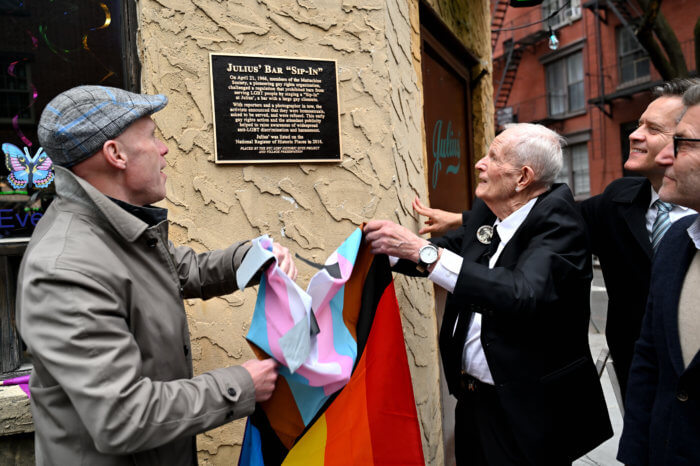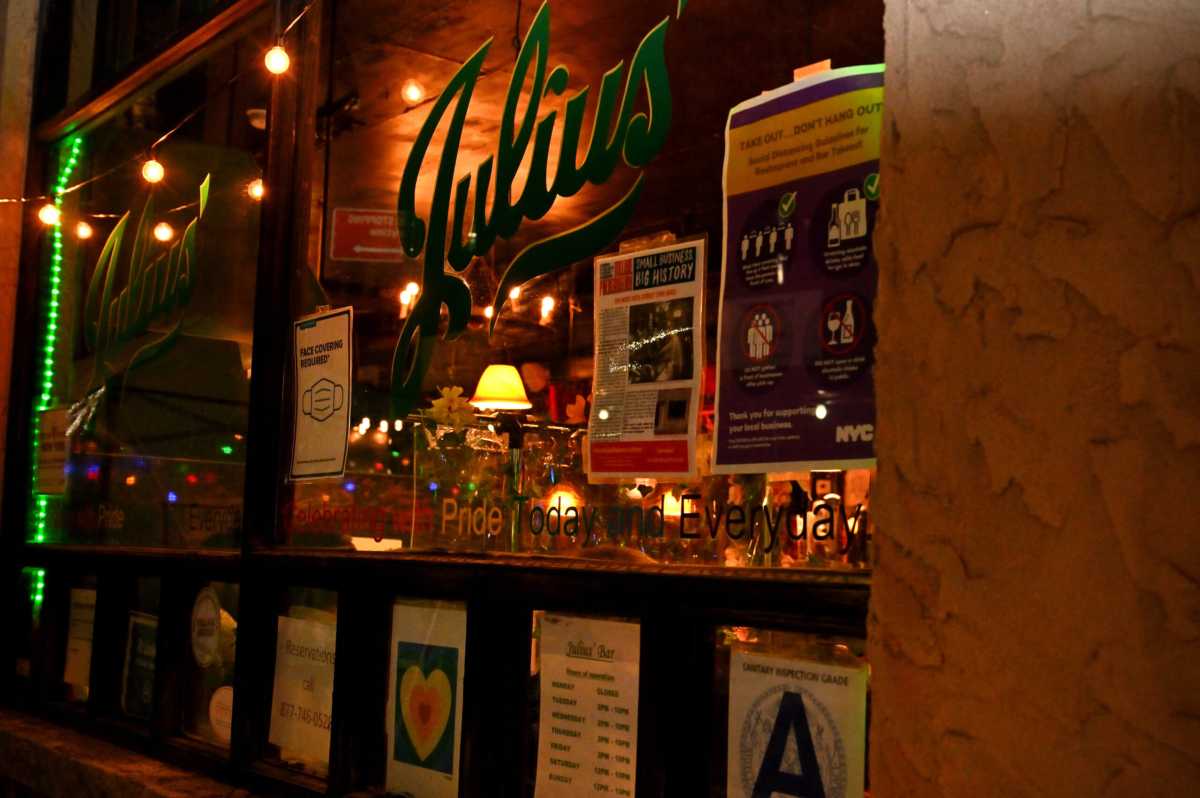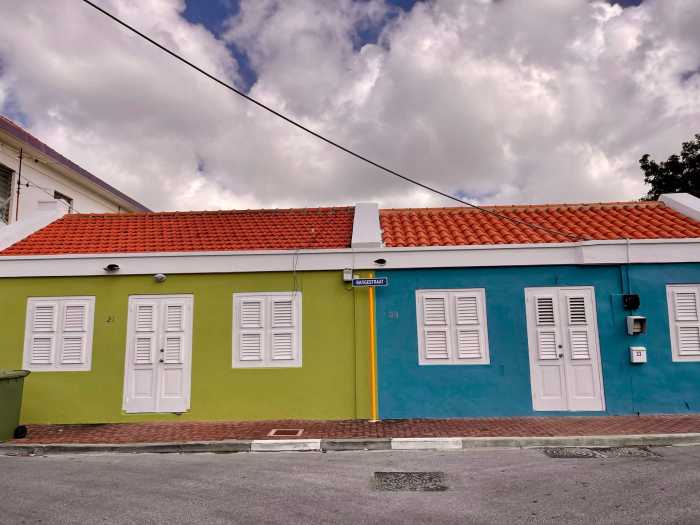The building housing Julius’ Bar, which is known as the oldest gay bar in New York City and the site of the 1966 “sip-in” event that helped catapult the right to drink for LGBTQ people, could soon be formally recognized as a city landmark.
The New York City Landmarks Preservation Commission (LPC) voted on September 13 to “calendar” — or set up for formal consideration — the bar’s building at 159 West 10th Street in Greenwich Village. The law stipulates that the LPC must hold a hearing and vote on landmarking the building within a year, according to Village Preservation, which is a non-profit organization dedicated to saving the architectural and cultural history of Greenwich Village, the East Village, and NoHo.
Julius’ building holds particular significance in LGBTQ history thanks to the sip-in demonstration that took place on April 21, 1966 — three years before Stonewall — when Mattachine Society members Dick Leitsch, Craig Rodwell, John Timmons, and Randy Wicker challenged the State Liquor Authority’s policy barring bartenders from serving LGBTQ people.
The four individuals, accompanied by the press, entered multiple bars and said, “We are homosexuals. We are orderly, we intend to remain orderly, and we are asking for service.” The first bars they entered were willing to pour them drinks, so they continued on to Julius’ bar, where a bartender placed his hand over a glass to demonstrate his refusal to serve them.
Advocates have long pushed for Julius’ to get landmark designation, which prevents significant changes to the building in the future, but that campaign is largely symbolic because the building that houses Julius’ already sits within the landmarked Greenwich Village Historic District. That area encompasses a collection of more than 2,000 buildings over 100 blocks in Manhattan.
“[Landmarking] the bar is very important because it marked one of the few sites that really predate even Stonewall in the beginning of the movement,” Wicker, a longtime LGBTQ activist, told Gay City News on September 13 as he recalled his role in the sip-in protest.

Village Preservation’s executive director, Andrew Berman, said the organization has been a proponent of the push to landmark Julius’ building for nine years.
“This is a tremendously important step toward conferring much-needed recognition and protection upon this site, which played such an enormously important role in the LGBTQ+ civil rights movement,” Berman said in a written statement. “We’re optimistic that it will soon join the ranks of other officially designated LGBTQ+ landmarks in our neighborhood which we fought for…”
Berman, Wicker, and others joined together at Julius’ in April of this year to mark the 56th anniversary of the sip-in. To this day, Wicker remembers walking from bar to bar as he and others sought to bring attention to the state’s discriminatory policy.
“Julius’ didn’t want to be a gay bar,” Wicker said. “In the afternoon, people in the neighborhood would stop in and have a beer and socialize, but because there was a large population of gay people in neighborhood, they had a large clientele. On the weekends, they kept an eye on how many males and females were in the bar because they didn’t want it to tip over into being all male.”
While other bars were willing to look the other way and serve the men regardless of the liquor law, Julius’ was on edge after one man was recently entrapped and arrested prior to the sip-in.
“[Julius’] got notice that the liquor license could be revoked if you got another incident like this, so that was the reason they really refused us,” Wicker added. “Because the police department could do this so they could start getting payoffs from Julius’. The precinct was very corrupt in that way.”
The rise of public-facing gay bars, Wicker said, helped spark further advances for LGBTQ rights and even drew the attention of political figures who started to realize the voting power of queer people in the area.
“Politicians started going to those bars seeking votes,” Wicker said.
Berman welcomed the LPC’s vote to consider the building, but he also emphasized that such designations are also needed for other places that hold significance in LGBTQ history.
“We hope the LPC will also take some not just symbolic actions to landmark LGBTQ+ historic sites currently entirely lacking in protection, which could actually be lost or compromised in some way,” he said, pointing to a list of sites rich with LGBTQ history. Those locations include spots like 55 Fifth Avenue, which was home to Columbia Photograph Recording Studios and OKeh Phonograph Recording Studios and brought in notable LGBTQ performers such as Blues singer Bessie Smith; 86 University Place, which was the site of a popular lesbian bar called “The Bag” and attracted customers such as Audre Lorde; and St. Ann’s Church at 120 East 12th Street, which hosted a funeral mass for trans performer Jackie Curtis in 1985.
The LGBTQ spots already landmarked by the city include the Stonewall Inn, which was landmarked in 2015, as well as six more sites that were designated as landmarks in 2019 — the year New York City hosted WorldPride: Caffe Cino at 31 Cornelia Street, the LGBT Community Center at 208 West 13th Street, the Gay Activists Alliance Firehouse at 99 Wooster Street, James Baldwin’s residence at 137 West 71st Street, the Women’s Liberation Center at 243 West 20th Street, and Audre Lorde’s residence at 207 St. Paul’s Avenue on Staten Island.
“LGBTQ+ and civil rights history like that which is embodied in Julius’ Bar are essential elements of our collective story, and it’s critical that they not be forgotten or erased,” Berman added. “We’re very fortunate that Greenwich Village is so rich in these threads of our history, and we’re committed to ensuring they are recognized and preserved, for everyone’s benefit.”



































